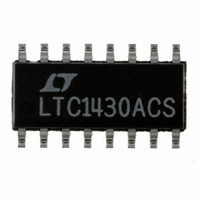LTC1430ACS Linear Technology, LTC1430ACS Datasheet - Page 9

LTC1430ACS
Manufacturer Part Number
LTC1430ACS
Description
IC SW REG CNTRLR STEP-DWN 16SOIC
Manufacturer
Linear Technology
Type
Step-Down (Buck)r
Datasheet
1.LTC1430ACS8.pdf
(24 pages)
Specifications of LTC1430ACS
Internal Switch(s)
No
Synchronous Rectifier
Yes
Number Of Outputs
1
Voltage - Output
3.3V, Adj
Current - Output
50A
Frequency - Switching
50kHz ~ 500kHz
Voltage - Input
4 ~ 8 V
Operating Temperature
0°C ~ 70°C
Mounting Type
Surface Mount
Package / Case
16-SOIC (3.9mm Width)
Lead Free Status / RoHS Status
Contains lead / RoHS non-compliant
Power - Output
-
Available stocks
Company
Part Number
Manufacturer
Quantity
Price
Company:
Part Number:
LTC1430ACS8
Manufacturer:
LT
Quantity:
10 000
Part Number:
LTC1430ACS8
Manufacturer:
LINEAR/凌特
Quantity:
20 000
Company:
Part Number:
LTC1430ACS8#TRPBF
Manufacturer:
LINEAR
Quantity:
12 711
APPLICATIONS
MOSFET Gate Drive
Gate drive for the top N-channel MOSFET Q1 is supplied
from PV
power supply input) by at least one power MOSFET
V
allows PV
up to 13V maximum. This higher voltage can be supplied
with a separate supply, or it can be generated using a
simple charge pump as shown in Figure 5. When using a
separate PV
inrush current if PV
93.5% maximum duty cycle ensures that the charge pump
will always provide sufficient gate drive to Q1. Gate drive
for the bottom MOSFET Q2 is provided through PV
16-lead devices or V
can usually be driven directly from PV
parts, although it can also be charge pumped or connected
to an alternate supply if desired. 3.3V input applications
use 3.3V at PV
Supply Operation for more details. The 8-lead part
requires an RC filter from PV
operation; see Input Supply Considerations.
Synchronous Operation
The LTC1430A uses a synchronous switching architec-
ture, with MOSFET Q2 taking the place of the diode in a
classical buck circuit (Figure 6). This improves efficiency
by reducing the voltage drop and the resultant power
dissipation across Q2 to V
USE FOR PV
GS(ON)
OPTIONAL
D
12V
1N5242
Z
CC1
CC
for efficient operation. An internal level shifter
CC1
7V
. This supply must be above PV
CC1
LTC1430A
to operate at voltages above V
Figure 5. Doubling Charge Pump
CC
supply, the PV
PV
and 5V at V
CC2
U
CC
CC1
/PV
PV
is present during power up. The
INFORMATION
CC1
U
CC2
G1
G2
ON
CC
MBR0530T1
CC
for the 8-lead device. PV
CC
and PV
= (I)(R
0.1 F
input may exhibit a large
to V
W
PV
CC
CC
CC1
Q1
Q2
DSON(Q2)
to ensure proper
CC
. See 3.3V Input
L1
CC
CC
with 16-lead
+
( the main
and PV
U
), usually
C
CC2
OUT
V
1430 F05
OUT
CC2
CC
for
,
much lower than the V
This more than offsets the additional gate drive required
by the second MOSFET, allowing the LTC1430A to achieve
efficiencies in the mid-90% range for a wide range of load
currents.
Another feature of the synchronous architecture is that
unlike a diode, Q2 can conduct current in either direction.
This allows the output of a typical LTC1430A circuit to sink
current as well as sourcing it while remaining in regula-
tion. The ability to sink current at the output allows the
LTC1430A to be used with reactive or other nonconventional
loads that may supply current to the regulator as well as
drawing current from it. An example is a high current logic
termination supply, such as the GTL terminator shown in
the Typical Applications section.
EXTERNAL COMPONENT SELECTION
Power MOSFETs
Two N-channel power MOSFETs are required for most
LTC1430A circuits. These should be selected based pri-
marily on threshold and on-resistance considerations;
thermal dissipation is often a secondary concern in high
efficiency designs. Required MOSFET threshold should be
determined based on the available power supply voltages
and/or the complexity of the gate drive charge pump
CONTROLLER
CONTROLLER
Figure 6b. Synchronous Buck Architecture
Figure 6a. Classical Buck Architecture
F
of the diode in the classical circuit.
V
V
IN
IN
Q1
Q1
Q2
D1
LTC1430A
1430 F06a
1430 F06b
V
V
OUT
OUT
9














